Making Apple Strudel
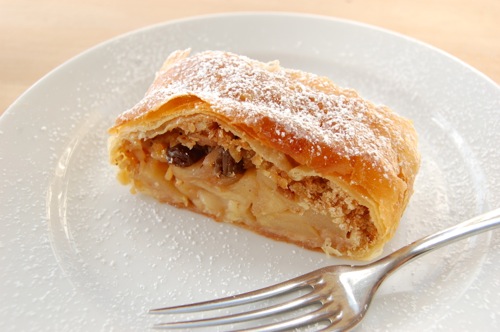
There’s a reason strudel has been consistently popular all over continental Europe for more than three hundred years: it’s pure, delicious comfort. It’s also fun to make, even when you count in the intimidation factor. The fear keeps you focused like a laser, and makes the exhilaration of baking up your completed roll tat much sweeter. Even more so than with a “fancy pastry”, you walk away from the strudel baking experience with a swagger. Oh yeah — baker in the house!
I strongly encourage you to try one this season. Start by assembling your ingredients. You want about six pounds of gala or golden delicious apples. This way you’ll end up with the five or so pounds you need for the actual filling. Peel them all the way around with a vegetable peeler.
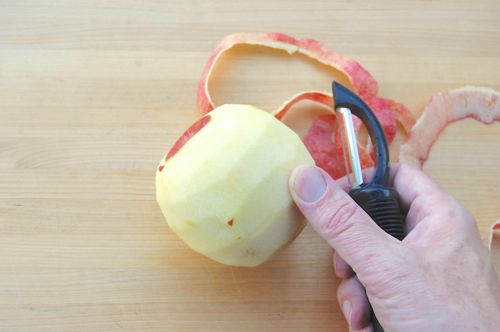
Cut them in half and core them with a mellon baller, then trim out the stems.
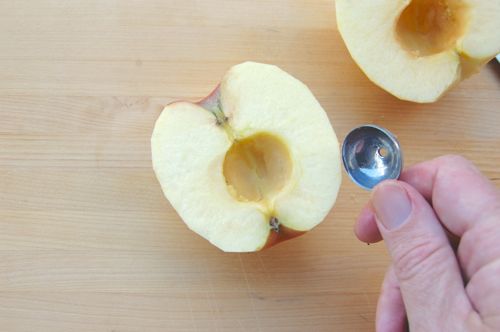
Cut the half in half…
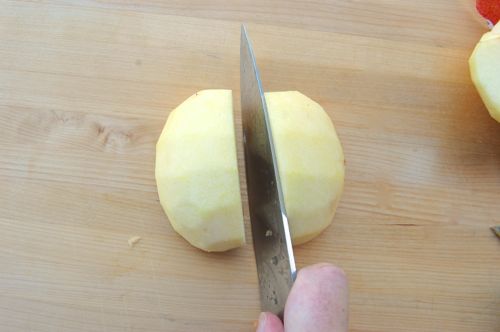
…then slice each half into 4-5 slices. Slice inward toward the center, angling the knife upward as you go.
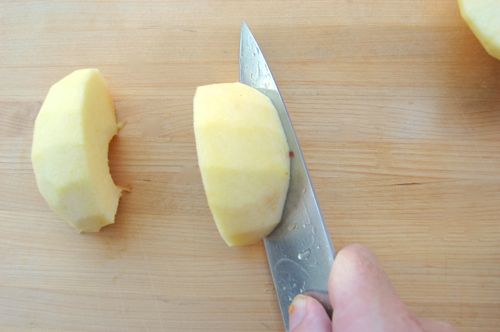
You’ll finish the cuts like so. Why do it this way? Because you’ll have consistent slices that cook up evenly. I should add here that some people like thicker slices, others like chunks. Just try to make them even whatever you decide on. One word of advice though, don’t make the slices too thin since even slices of firm apples can get mushy if they’re too skinny.
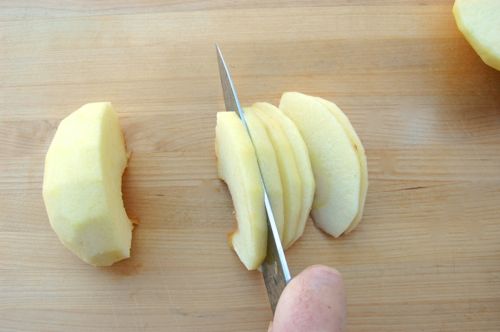
Oh yeah…repeat with the other quarter, then all the other apples, obviously. Drizzle lemon juice over the apples as you go to keep them from getting too brown.
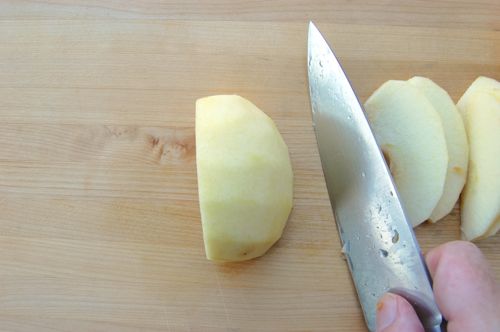
Next, over medium heat melt the butter in a large pot or saucepan and add the sugar, zest and cinnamon.
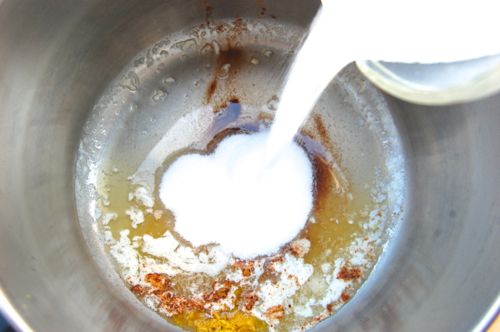
Add the apples and toss everything together. Once you hear the apples sizzle a bit put the lid on the pot and let them cook for 10 minutes.
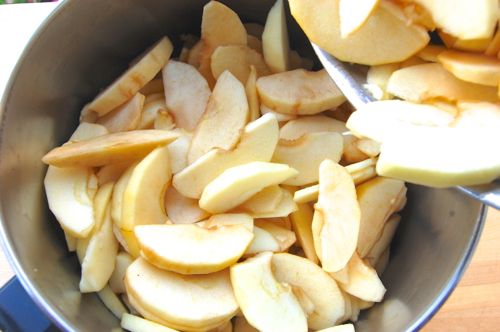
After your time is up, you’ll see that there’s quite a bit of juice in the pot.

Remove the top and keep cooking for about 10 more minutes. At that point you’ll probably still have some liquid in the pot. Taste one of the apples. If they’re still quite firm keep cooking them another 5-10 minutes or until the liquid is mostly gone. If the apples are at the perfect point or seem to be getting too soft, remove them from the pot with a slotted spoon or spider, then turn up the heat on the juice (this will keep them from overcooking). Reduce the juice down to a thick, bubbly syrup, then remove the pot from the heat and put the apples back in. Stir gently to coat the apples with the syrup. When it’s all done, spread the filling out on a sheet pan to cool.
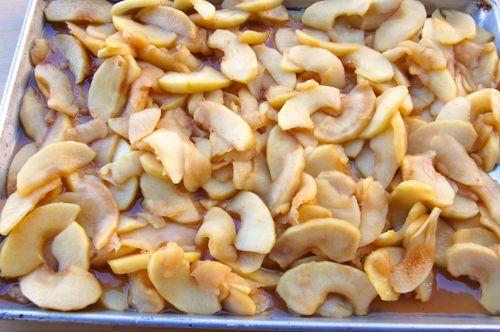
Meanwhile, add the rum to your raisins and zap them in the microwave for about 45 seconds. Leave them to cool as well.

Now for the dough. Beat together the eggs and the oil.
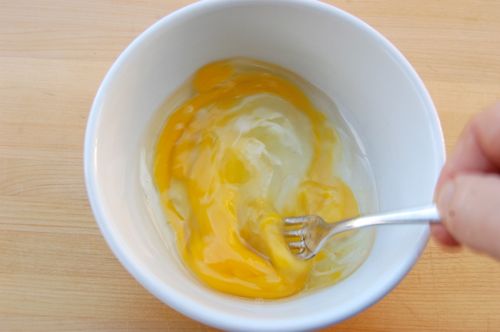
Put the bowl on a digital scale and add milk until you have 10 ounces total. You can also do this in a clear measuring cup, adding enough milk until you have 1 1/4 cups.
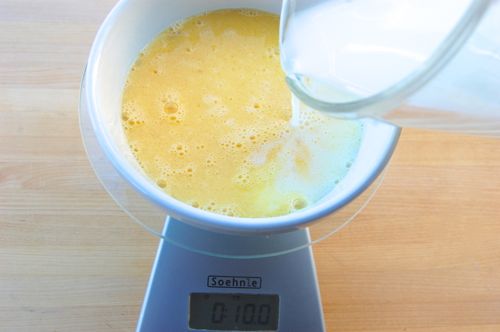
Combine your flour and salt in the bowl of a stand mixer fitted with a paddle. Stir it on low for about 20 seconds.
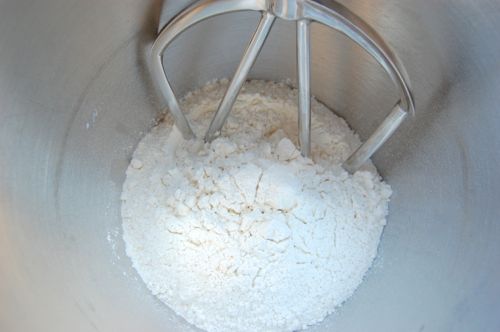
Add the egg mixture and continue to stir for about a minute more…
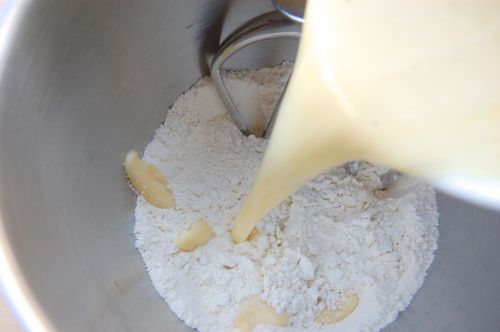
…until a shaggy dough comes together.
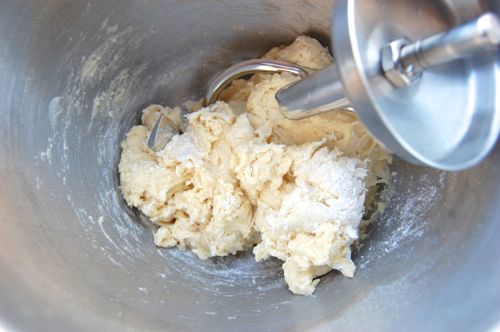
Knead the dough for about another 2-3 minutes until it becomes very smooth and stretchy. It’ll be tacky to the touch but shouldn’t actually stick to your fingers. If it leaves bits of dough on your fingers when you handle it, knead in another tablespoon or two of flour.
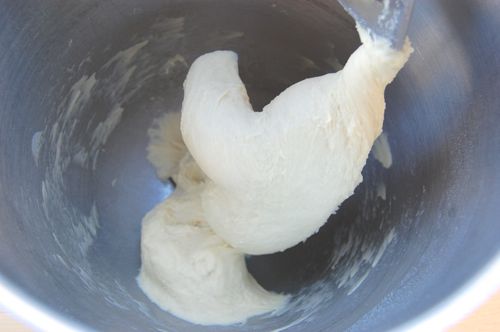
At this point it’s traditional whack the dough on the counter exactly 100 times. If you feel like doing that for tradition’s sake, by all means do so. It’s fun but it’s not at all necessary. Form it into a ball and put it in a lightly oiled bowl (roll it over once or twice to coat it). Let it sit at room temperature for 1-2 hours.
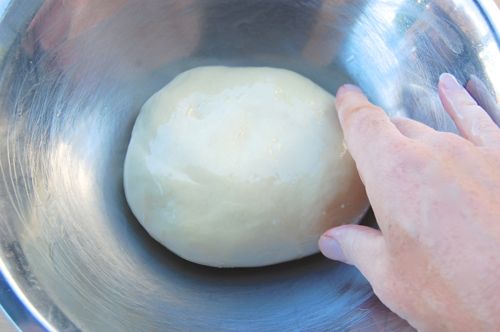
Dough ready and filling cooled, it’s time to make the strudel. Preheat your oven to 400 degrees Fahrenheit.
Here we shall adjourn to the Pastry dining room for the shaping. Now, some people get worried if they don’t have a small table that’s precisely the right dimensions (a lot of people shoot for a strudel that’s 2.5′ x 4′ or so). All we have is a large dining room table. It works just fine for strudel when we’re not entertaining heads of state.
Here you get a small glimpse of how we keep house here at Chez Pastry: we don’t iron our sheets. That might be a disappointment to some of you, but really, how often do guests look under the bedspreads at your house? Don’t answer that. Your personal life is your own concern. All I meant to say was that we’re a baking-centric household. What we may lack in pressing we make up for with pie. Anyway, throw a clean sheet over your table.

Dust it liberally with flour, but more than that, rub the flour into the fabric where you expect the dough sheet to be. Like so.
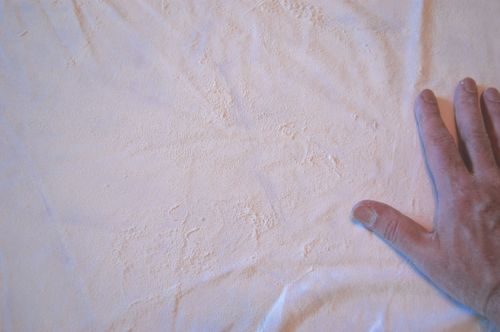
Now for the rolling. Remove the dough from the bowl and wipe any residual oil off the bottom with a paper towel (you’ll thank me later when it’s laundry time). Dust it with flour on the top.

Now apply your largest pin.
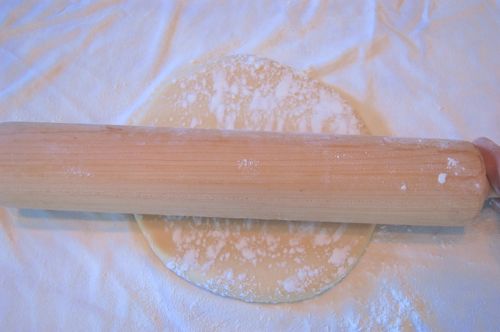
Roll the dough out to about a 2′ square.
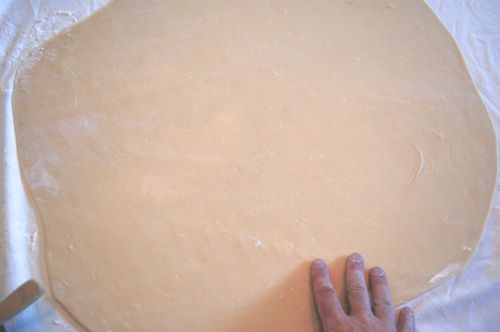
Butter it. This will make sure the top is nice and supple for the stretching.
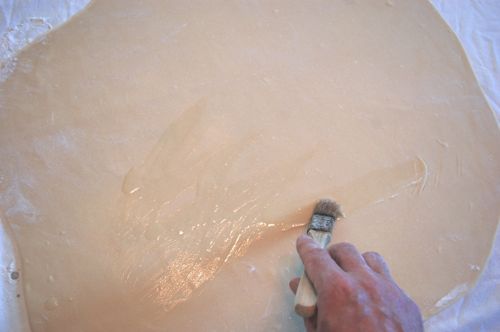
Get all the way out to the edges.

So OK. You’ve got a mass of dough in the middle of your dining room table and it’s time to stretch. You’re thinking: can’t some little old Slovenian lady come over and do this for me? Nope, they’re all off making kolacky this week, so it’s all up to you. Just begin slowly. Go around the edges and tug gently. Not so difficult…and the sheet is actually getting bigger.
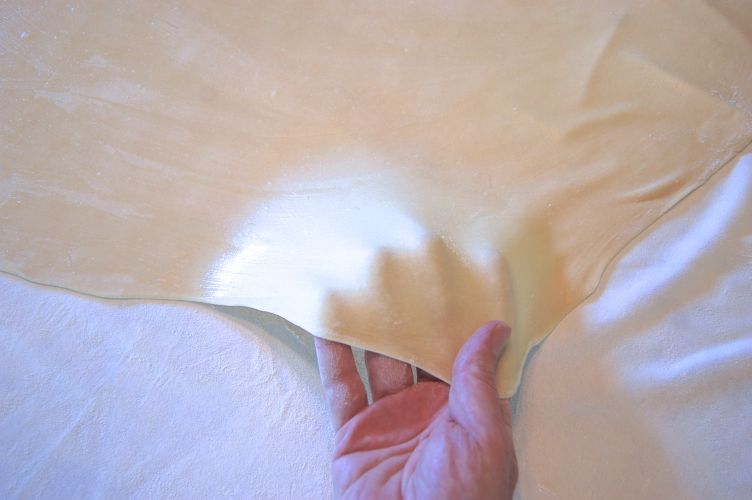
As you go you’ll notice that the thinly stretched regions of the sheet are looking lighter in color than the thicker areas. To stretch those out you’ll need to get further underneath. There are a couple of techniques you can use. You can use the backs of your hands and/or fists:
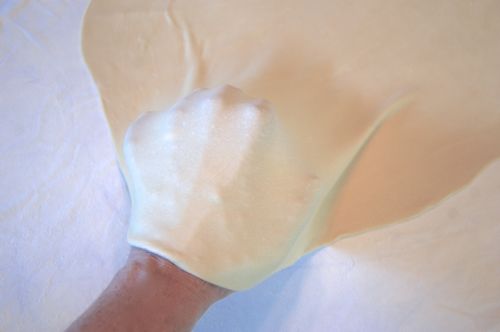
Or you can use your palms. I prefer the palms because I can open my fingers if need be to expand a small area. But experiment for yourself. It gets fun after the initial feeling of terror. Just move slowly and deliberately in smooth motions. Like you’re doing t’ai chi or something. And if you get a tear or two, no worries. Just move to a new part of the sheet. The strudel will still roll up fine.
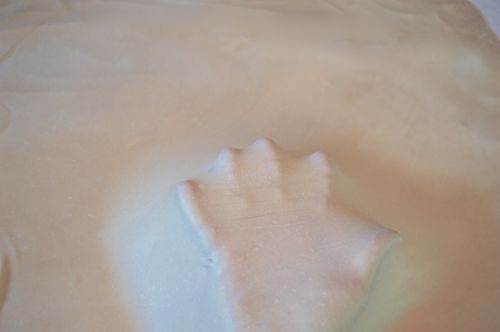
My sheet is about 4′ x 3′, but dimensions aren’t really so important. Thickness is the main thing.
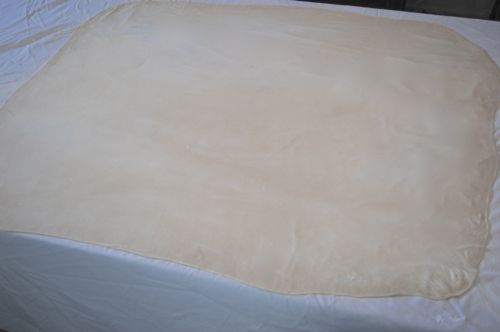
You want it thin enough so you can see a printed page through it. Here we have some of little Jo’s piano music. You’ll be amazed at how easy it is to stretch the dough this thin.

The filling-side edge of the dough should be hanging over the table just a bit. When you’re ready to lay the filling down, go around with some scissors and trim off the very edge. It’ll be dark and thick (no good).
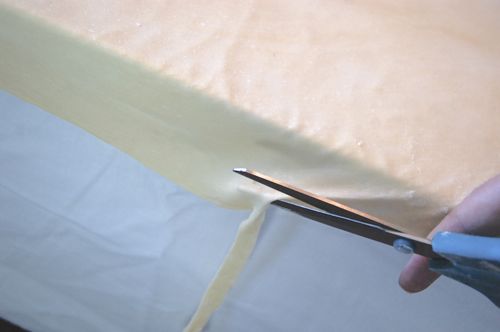
Next, re-butter the whole sheet. Gosh I wish I could find my bigger brush!
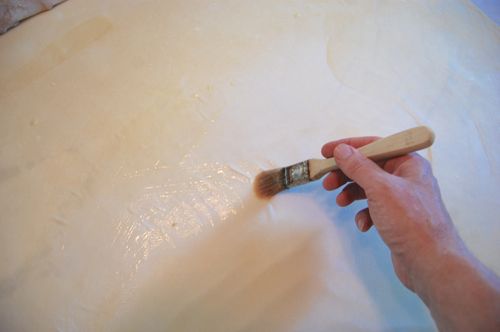
Begin the filling by laying down your bread crumbs. These are some “white” wheat bread slices that I ground up in the food processor and dried on a sheet pan last night. They worked perfectly.
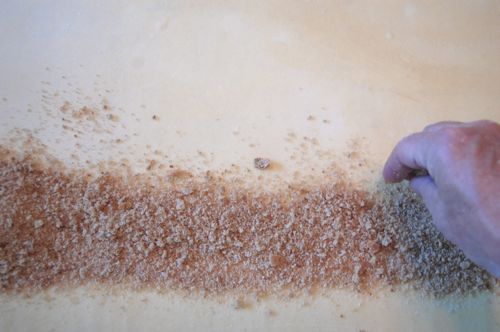
Now lay down your toasted nuts followed by the raisins and the apples.
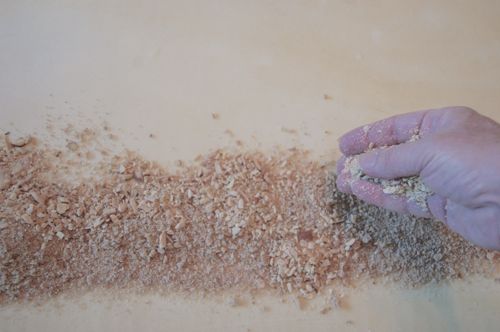
You’ll have a nice long stripe of filling. Make it as wide or narrow as seems appropriate. You can worry about getting it on the pan later.
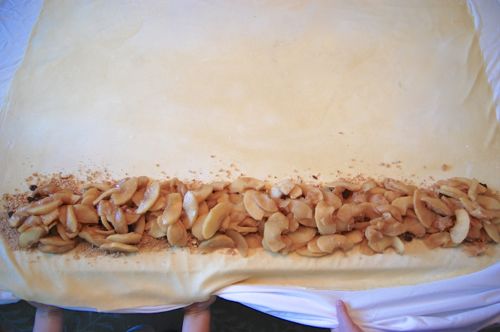
Bring the edge of the sheet up and flip the edge of the dough over onto the filling. See I have some young helpers here? Little Jo and Joan Pastry were eager to get in on the action.
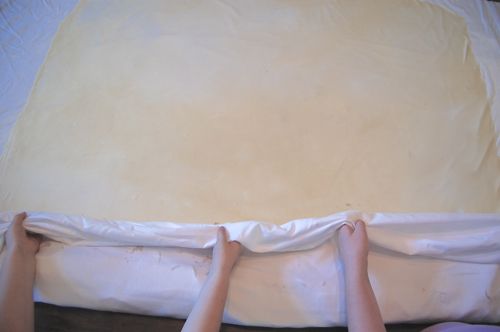
Successful flip. Gather up the sheet behind the strudel and repeat the motion, easing the whole thing over…and over…and over again…

…until it’s all rolled up. Easy. (Really).

Now trim any spare dough off the ends, leaving two inches or so, then tuck the spare dough underneath.
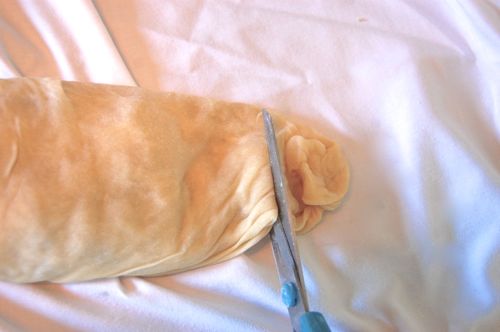
Here’s how I panned this strudel. I put a half sheet at a perpendicular angle right in the center.
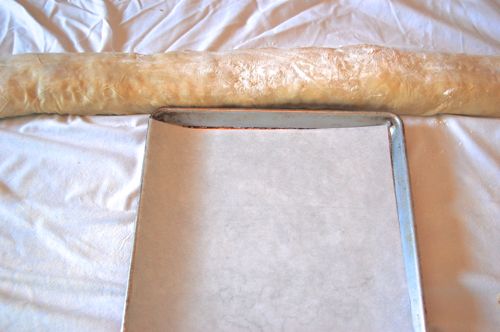
I slipped my hands under one half, then brought it down.
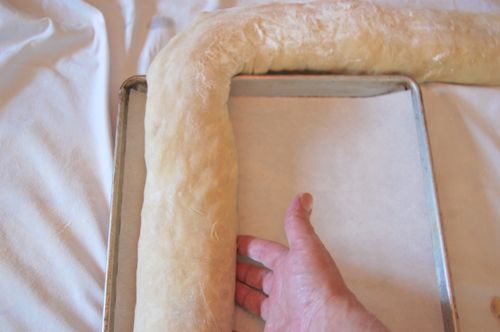
I did the same on the other side…

…then the middle.
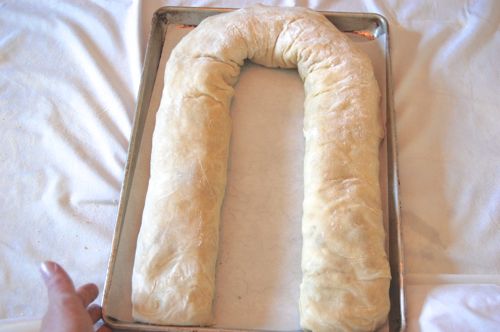
Here I should insert that there are lots of ways to go here. If your strudel is long and skinny you can make an “S” shape. You can make a shallow “U” if it’s very short and thick. If you have a really odd shape or thickness and can’t get it into a sheet pan, then slip it onto the back of a pan…or the backs of TWO pans if it comes to that (in which case, get a friend or family member to help you ease the whole thing into the oven). There is no set shape for a strudel.
Can you cut it into pieces if need be? Yes, thought that’s not ideal for a couple of reasons. First, you lose a lot of juice. Second, if you live somewhere where gluten is elastic (America, Canada…perhaps Australia though I’m not really sure), the dough will want to shrink up during baking. So if you must cut the strudel, let it rest on the counter from 30-45 minutes before baking to minimize it.
Did I mention you can freeze the strudel for later baking at this point? You can, for up to a couple of months.
Paint on some egg wash or simply butter if your prefer. Rest the whole pastry for about 15-20 minutes (again, especially if you’re a New Worlder) to relax the gluten and minimize cracking.
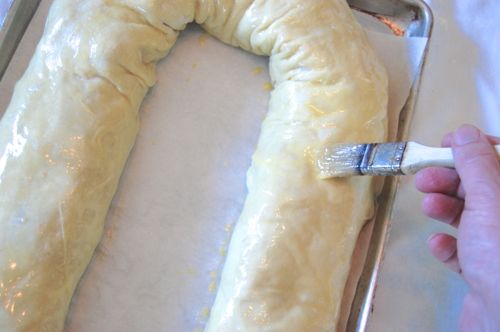
Bake at 400 for a total of about 40 minutes (check it and rotate it at 20 and 30 minutes to keep an eye on the progress). You want it nice and dark brown. The reason I recommend high heat is because you want to brown it reasonable quickly. If the filling gets very hot all the way through you’ll generate steam and the filling will burst out the sides. The high heat will brown the strudel without getting it too hot in the center.

Ah yes, perfecto. Here we actually have three strudels: two “I” shaped ones and one “C” shaped one. Lemme tell you, the neighbors were happy. Really, really happy.
Let the whole thing cool completely before you cut it. Serve it at room temperature, dusted with powdered sugar. Reader Gerhard in Vienna made me swear I wouldn’t put any whipped cream, custard sauce or ice cream on this, as it’s apparently scandalous there. So I understand, it’s the Germans that added the rich adornments. God I love those people.

I won’t tell you what to do with yours, other than enjoy it.
Can you cut steam vents in the top so the hot filling will not burst the strudel? Or will you lose juice that way?
Alas no. The dough is stretched so tight the strudel would pop open if you were to puncture it. Just keep the heat high and an eye on it in the oven and all will be well. However it occurs that if you were to poke a few vents, say, after the first 15 minutes when the outside of the dough has crisped a bit, that would prevent both bursting and runaway vent expansion. Thanks for the question, Ellen!
– Joe
Hey Ellen!
I’ve reconsidered my reply here. I think it man be alright provided the roll isn’t terribly tight, in which case up could get quite a lot of tearing during the bake.
– Joe
That is truly a thing of beauty. Great post, definitely one for the ages.
If you mean it’s my longest ever, then I suppose so! 😉
It’s like…45 photographs.
But thanks! I had a great time with it!
– Joe
I am just alternating between saying “wow” and drooling!
Ha! Thanks Malini!
– Joe
Hi Joe,
Is there a flavorful, nonalcoholic substitute for the rum which one could use to plump up the raisins? Also, can you suggest some strudel fillings for the other seasons?
Thanks so much for the fantastic tutorial. The strudel is gorgeous!
Thanks Carol!
If you don’t want to use rum, orange or apple juice is a fine substitute. For other seasons, well, there’s no end of substitutes. A Bulgarian reader spoke of her mothers’s pumpkin strudel today. Sour cherry is a Hungarian classic. Spinach, chard, mushroom, rice, cottage cheese, liver, apricot, prune, poppyseed, cabbage, nuts, jam…it’s almost limitless. Have a look at the bake-in fillings in the Components section for a few ideas. Then…let your imagination be your guide! Have fun!
– Joe
What’s your impression of Rose Levy Beranbaum’s version in Pie/Pastry Bible? She goes with a leaner dough and does recommend cutting vents. I want to try the recipe with which I’ll have the most success
Hi Amy!
Rose doesn’t use eggs, but her dough is quite a bit richer than mine in the oil that it contains. As for the steam vents, it really depends on how taught the dough is when you’re done rolling. If it’s quite tight there’s a risk that the dough sheet will open and run like a snagged nylon stocking in the heat. However if it’s slack and rested it’s probably worth the risk, all things consided. What I will say is that a long bake will also cook the apples more, which can be a good thing or a bad thing depending on how soft you like the fruit.
Thanks for whe question!
– Joe
Thank you! Having a 1/2 Hungarian father, I cannot wait to make this for his birthday!
Have fun, Amy! And tell me how it goes!
– Joe
I LOVE making strudel for that same post-baking “swagger” that it gives me. “You made that?!?” “Yeah, it’s no big deal or anything.” 😉
Exactly. “Yeah, I just do this on weekends.”
That’s it!
– Joe
Gorgeous! And your excellent pix make me want to give stretching dough a try. …tho I suspect taking care of a 2yo and getting dough you can read music through aren’t natural companions. =o Still, I’m definitely archiving this tutorial and thanking you profusely.
Any thoughts on how yeast dough for potica might require different handling? Or would a good rest do the trick, do you think?
Ever tried Judy Rodgers’ roasted applesauce? I want to see if it would be possible to get that fantastic roasty flavor boost, the zip of a splash of vinegar and still achieve the firmer texture that a streudel needs for slicing.
Thanks Rainey! It’s my very great pleasure as always! My youngest is five so…she’s fairly manageable now. Except when she’s fighting with her 8-year old sister!
I’ve never handled a yeast dough that’s this thin, to be honest. However my feeling is that since it’s yeasted and will have some gas pockets inside, it won’t be as flexible. I have a feeling you’re in for more rolling than stretching on that. Hmm…you know, I should probably just make it in the next week or two to find out. Think?
But no, I’ve never tried that applesauce. I will!
– Joe
This is very impressive!
Thanks Kathleen!
– Joe
You amaze me! This is incredible!
It’s really pretty easy when you get down to it, Tora. You should try it!
Cheers and thanks for the message!
– Joe
It seldom occurs to me that you have neighbors that get to enjoy your creations without having to make them! I guess I’ll have to make this after apple picking soon!
I generally unload things wherever it’s convenient. Usually it’s my wife’s graduate students, but if neighbors are handy then I consider them fair game! 😉
Let me know how it turns out!
– Joe
We’re friendly down here in New Orleans too – great neighbors (just a hint). We’ll even makes drinks for you while you’re working.
The only drawback that as we sit together eating, we’re trying to figure out what the next meal will be.
Very thorough tutorial – the best I’ve seen on this. I believe I may attempt this in the future now, at least once. How long did that take?
Hey Naomi — and thanks!
It actually took me longer to do the post than make the strudel. Start to finish is was about a 4-hour job with baking time.
Glad to know there are other people out there who talk about dinner over lunch!
Let me know how your strudel turns out.
– Joe
Great tutorial, Joe. I went on the hunt for strudel last winter. I’ve only liked it since then when I had some from a bakery where they apparently did the table stretching of the dough. It was layer upon layer of the crispyest, flakey pastry I’d ever eaten…and it wasn’t tough, which is the reason I’d never really cared for strudel before. Why, or how, could strudel pastry get tough and bread-y instead of tender and flakey? I’ve experienced the same toughness in croissants before.
Glad you asked that Susan. The toughness comes from the flour. Which is to say, some recipes call for bread flour versus standard all-purpose. The extra gluten helps the dough to stretch, which makes the preparation easier, but when it bakes up it can have that hardness you mention. So while there’s always a temptation to go for the easier stretch, you pay the price in the end.
Thanks for the great question!
– Joe
Is there a trick to getting the crumbs and the seam on the bottom? Or do you just wing it?
Mine are on the top, as you may have noticed. I don’t really keep track. They’ll absorb moisture either way, however.
Good question!
– Joe
I’ll be honest & admit to just buying frozen philo because I am lazy. But you inspired me & a neighbor gave us a bunch of winesap apples this weekend so I decided what the hay.
Have not stretched dough in maybe 20 years & it brought back so many great times with my mom – I feel guilty I didn’t do this more with my kids. Thanks so much for a perfect recipe and some fabulous memories!
My pleasure, Frankly! Give it a whirl and let me know what you think!
– Joe
Had already done it! It brought back so many great memories. I love your recipes because I know you have actually worked them out so its pretty hard to fail.
My mom used to do these sorts of things all the time but life is so busy these days that the effort to pull the dough with the care needed just isn’t expended. Its worth the time as the crust is unlike anything you get from anything else.
Thanks
Very nice of you to say, Frankly! And I’m so glad you went ahead and did it. Fun, right? 😉
– Joe
Those sound like great memories and I agree with you that Joe’s tut is inspirational and confidence-building.
Still, it’s great to know that the frozen phyllo dough is a fast and available alternative. I think it works great to make a crisp and tasty strudel in a flash. I’m sure you don’t get to strut quite as proud though…
You can also use Mille-feuille type dough or puff pastery, none is really ‘wrong’ and each has its own charm. Maybe because its memories of childhood and mom but the dough Joe has is the best by far to me.
Not sure if he has ever ever done Mille-feuille (I’m gonna check here in a minute & see if I can find it) but that is good for a lot of things too. I helped make phyllo once. While that would be “fun” its a PItA
Of course Joe does! This is a pretty basic thing in the pastry world
http://joepastry.com/category/pastry-components/puff-pastry/
The way I was taught is pretty close to the method Julia Child shows in her book but is really not much different. The great thing about both her & Joe is you know they have actually done it and it works.
😉
Joe,
Once again, first-class tutorial! I just moved to Stuttgart, Germany, where even at the local grocery-store bakery the pretzels and strudels are amazing (and they are iced here, much to my delight). I may have to give this a try, just for the wow factor of stretching the dough out on the kitchen table.
By all mean proceed, Sgt., and then file a full report. I think you’ll impress a heck of a lot of Germans with your strudel making ability. Precious few of those folks even bother these days!
Cheers,
– Joe
Hi Joe,
I had tried making strudel in the past, but with no success. I should mention that I’m from Canada, and our all purpose flour is not only very high protein (12%) but also very elastic. Therefore, it’s always difficult to make pizza or any dough that must be stretched out (you just end up rolling once, resting, rolling once, etc.).
I then lived in Germany for a few months. They sell flour there just for strudel dough – what a difference it makes! It stretched out paper-thin at a touch … beautiful! I haven’t made it since coming home to Canada, but maybe I’ll see what I can do with a mix of all-purpose and pastry (also hard to find … we mostly have cake-and-pastry, which is chlorinated).
For the reader who just moved to Germany – the bakeries are excellent, but it takes awhile to get used to baking there. They don’t sell measuring cups or spoons (they have measuring “cones” that measure set ingredients by volume), no brown sugar, baking soda, etc. only in little packets. It’s interesting but different – most everything is geared towards making cakes (you bring a cake on your birthday to the office) but other than that, you mostly get everything at the bakery.
Hey Tamara!
Thanks for this! The gluten in American flour is the same way: elastic instead of plastic. Hard red northern wheat, in other words. However I used that very thing when making this strudel. If you let it rest a bit as you stretch it (keeping it well buttered of course, so it doesn’t dry out) the result is outstanding. I encourage you to give it another try! Let me know what happens!
– Joe
Hi Joe! I made Povitica some time ago which was done stretching the dough like for strudel. I do want to try the strudel though because the recipe is different. I am tempted to try using some whole wheat pastry flour mixed with my all purpose. What do you think? (Maybe I should do the recipe as written first?) Anyway thank you for the great post and instructions!
Donna
Hey Donna!
I myself might make some povitica soon. I got several requests after the strudel was done. Regarding the wheat, I’d tread lightly there since the bran particles in whole wheat flour undermine the dough’s ability to stretch. If you’re going to go that route, I’d try adding some bread flour to the mix to beef up the gluten content. Best of luck and let me know how it goes!
– Joe
Have you ever considered making a Slovenian Potica for a baking project? It is a yeast dough strudel – nut, poppy seed, etc. Often made more in a loaf pan shape, so it is higher and has more layers of dough/filling. I have been experimenting with new fillings – cranberry walnut as well.
I have it on my project list, Michael, but haven’t done it yet. Any recipes you especially like that you might be willing to share? 😉
– Joe
Great tutorial! I have made the traditional Hungarian cherry strudel a few times. I did as you suggested the last time and didn’t beat my dough on the counter 100 times. It was much more tender and flaky, not tough. Thank you! No matter what I have done though, I can’t prevent the bursting and leaking. I have cooked the cherries and juice ahead of time, I have thickened with corn starch, with tapioca, I have squeezed all the juice out that I could…. Any advice? Thank you!
Hi Janet! I feel your pain. No matter what you do there’s still going to be steam in there that wants to expand. You can try a small amount of venting (little cuts to release steam), however I generally prefer to just use a fully cooked filling, then use the baking to brown up the crust. If the filling doesn’t get blistering hot all the way through you get less steam…but since the interior is already cooked it’s not essential anyway. Know what I mean?
Thanks for the question!
– Joe
Hello Joe, Once a month our cardiac rehab group gets together to sit around munching on supposedly healthy food and fruit. About 6 months ago I tried making apple strudel with the frozen phyllo dough which is less work for me. My first attempt was a hit, using granny smith apples, pears, and walnuts. I had one complant about the nuts so they are out now. Then I added dried cranberries and now have added cherries (rinsed cherries from Cherry pie filling). Once all the ingredients are together,table cleared and oven warmed up, its easy. My problem is my two young grandchildren.. they just look at it and say “I don’t like it!” Thanks..
Love that cranberry idea. Thanks for the note, Jack. I have the same trouble with my little girls. One day they shall be converted!
– Joe
Do you know of a frozen food mfg of strudel? Thanks for any information.
Hey Pete!
A commercial supplier you mean? I’m sorry but I don’t. Best of luck with the search!
– Joe
Hi Joe
You said you can freeze the strudel before baking, do you need to thaw it or can you bake it directly out of the freezer? And if I need to thaw the strudel can I do so overnight in the fridge?
Thanks
Tracey
Hey Tracey!
You will indeed need to thaw it — overnight in the fridge as you correctly assumed. That should do the trick! Send pictures!
– Joe
Hi Joe,
My Slovenian friend bakes it with cream on top of the strudel and also brushes it with cream inside before rolling and I notice you have used butter. Does it make any difference which is used?
Thanks,
Keerthi
Hi Keerthi!
Sounds good to me! The cream simply gives a different finish. In general eggs deliver more shine and cream (or milk) deliver more browning. It’s a personal choice. You can combine the two as well if you like for something in between!
Have fun!
– Joe
I’ve never made strudel; had it in the Dolimites this past Fall and want to make it for an OpenHouse for our Lesiure Arts Group Open House, next Thurs. with mulled wine. Do I need to practice before I try to do this?
You can if you like. Honestly It’s not so tough if you just give yourself plenty of time and butter! A few rips won’t matter a bit. It all depends on your standards for the final product. I’d never made my own before I tried this, and as you can see it turned out nicely.
Have fun and let me know how it goes!
– Joe
Thanks for not making me sign up to make a comment.
Mab
No problem! Those forms really bother me as well!
Cheerio,
– Joe
Thank you so much for this recipe. I made it and it brought back so many wonderful memories of my Grandmother, unfortunately I never got her recipe before she passed away.
I used bread flour when making my strudel and found the dough to be a bit dried out/ cracking before I baked it. Do you think the bread flour was to blame?
Hi Kathy!
Very nice to hear that! Regarding the dough, the extra gluten probably did make the pastry a bit tougher, though it likely also gave you some extra stretch. You can try an all-purpose next time and see what you think!
Let me know!
– Joe
Also, I grated my apples like she did and spread them out over the entire dough. I felt like the strudel could have used more filling. Have you ever increased the filling amount by half?
Hello again!
Grated apples should create a denser filling, so that makes sense. You can certainly add more if you like!
– Joe
Oh my gosh…..took your advise about the all purpose flour, didn’t stretch is as much used extra filling……it was to die for! That you so much!
Woohoo! Thanks Kathy! Glad it worked so well!
– Joe
Hey Joe,
Can you tell me what the best way to store this strudel to help keep it flakey?
Thank you!
Hey Mick!
Keep it loosely tented with aluminum foil at room temperature. It’ll keep well for a couple of days!
– Joe
Thanks for the beautiful article. A lot of strudel recipes use oil or butter only (no eggs or milk). Why do you prefer to use the eggs and milk? Is it taste or does it impact the stretchability of the dough?
Hi Miriam!
It does all that, improves flavor and elasticity, plus I like the rich color that the eggs give the dough. A lot of strudel is very pale even after it’s baked, and I confess I don’t really like that. The tinge of yellow makes it more inviting to me.
Thanks for the question!
– Joe
Hello, a very good tip about leaking stuffing, which was always my strudel, baked at a low temperature and the filling leaked, now I bake at high temperature, thanks! 😀
Glad it worked, Eduardo! Thanks for the note!
– Joe
Hi Joe,
Thanks for your detailed post. I got the strudel dough down but I tried doing cheese filling instead of the apple twice now and both times I had explosions during baking. I’m using 2 lb farmer’s cheese, 1/2 lb sour cream, 5 egg yolks, sugar, etc. Do I need a different dough for cheese or do you have any other suggestions? Thanks
by the way, the apple strudel didn’t rupture so I did have success before I tried the cheese filling
Good to hear, Sally! Best of luck!
– Joe
Hi Sally!
Any time you’re doing a filling that you need to heat through you’re going to have explosion problems doe to steam. You might try cutting the strudel into smaller pieces before baking so the steam can escape out the ends as it bakes. That about all I can think of!
Good luck!
– Joe